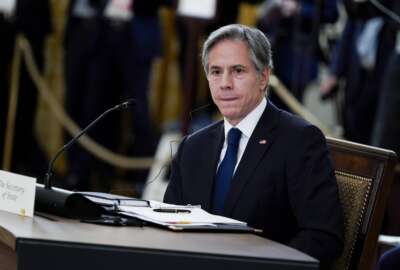
Hubbard Radio Washington DC, LLC. All rights reserved. This website is not intended for users located within the European Economic Area.
Hubbard Radio Washington DC, LLC. All rights reserved. This website is not intended for users located within the European Economic Area.
The State Department is broadly re-imagining the future of work for its domestic and overseas employees, with accessibility at the core of these changes.
The State Department is broadly re-imagining the future of work for its domestic and overseas employees, with accessibility at the core of these changes.
Deputy Secretary for Management and Resources Brian McKeon said the agency is looking at telework beyond the scope of reasonable accommodations for eligible employees, as something that much of the workforce can benefit from, particularly for employees who don’t work on classified issues.
“It’s clear that we are not going back to the status quo ante of February 2020, where most people come into the department every day,” McKeon said in a recent interview. “We’re going to have to adjust and have a hybrid work environment that provides flexibility for employees, but it will be based primarily on people’s jobs and function.”
McKeon said the State Department on April 25 reached the “all functions in” point of its COVID workplace framework, which means more employees have come back into their offices.
Prior to the “all functions in,” McKeon estimated about 40-45% of the department’s workforce was already working in-person, at least for its headquarters in the Foggy Bottom neighborhood of Washington, D.C.
As for the hybrid workplace the State Department is developing, McKeon said the department has developed a mobility assessment tool, which is a questionnaire that examines every position by mission or function, and comes up with a maximum telework eligibility score.
“Our supervisors and employees would have a conversation to decide, ‘OK, this is how much we’re comfortable with you teleworking,’ and they come to an agreement. But the mission still has to be performed. Our first principle here is mission first. So even if somebody is telework-eligible for three or four days a week, if suddenly there’s some crisis work that requires a greater onsite presence, managers can adjust and ask people to come in,” McKeon said. “But the new normal will be that we are not going to have 95% of the people in the department on a day-to-day basis. It’s going to be a smaller number, because more people will be teleworking. We have a lot of positions that don’t require classified work, and if people want to telework several days a week, and they’re eligible to do it, that’s what they’re going to do.”
As employees return to their offices, the State Department sees its state-of-the-art Access Center as a critical element of its workplace accessibility goals.
The department’s Bureau of Global Talent Management opened its 2,400-square foot Access Center in 2020, across the street from its Foggy Bottom headquarters. The center provides assistive technology to employees with disabilities.
“It’s easy to understand, I think, how someone who is disabled may not always feel included because of the impediments they face just on a daily basis,” McKeon said.
At least 17% of the State Department’s civil service workforce has at least one disability.
“We’re very focused on DEIA — diversity, equity, inclusion and accessibility — and this is the way that we’re trying to give meaning to accessibility to our disabled colleagues, to give them opportunities to have assistive technology that will help them at their workplace, whether it’s here domestically or on an overseas assignment,” McKeon said.
The assistive technology the Access Center offers runs the gamut from ergonomic computer mice and keyboards to screen magnifiers, assistive listening devices and deaf-to-hearing communication systems.
“Some people may have new disabilities as their life and career go on, and they may need different things as they get older. It’s a place for people to come, to feel safe, that’s confidential — they don’t have to tell colleagues they’re doing it — come here and understand what’s available to them to help them do their job wherever they’re doing it,” McKeon said.
McKeon said the center is also available to supervisors and managers to better understand the workplace needs of their employees.
“You may have a supervisor who, for the first time, will be supervising a disabled employee and wondering, ‘How is this going to work? Are we going to have to set up some special space for them? Do we really have the ability to support this officer to adequately do their job?’ So they can come here and see what’s available and understand how well we can integrate a workspace for a disabled officer,” he said.
The State Department’s Access Center is the largest of its kind in the federal government.
Jameela Akbari, director of the Office of Accessibility and Accommodations, which oversees the Access Center, said officials toured similar facilities operated by the departments of Defense and Agriculture prior to completing the facility.
“Not only are we a model within the department, but because of the department’s foreign policy mission, the Access Center can also serve as a model to the rest of the world, in terms of accessibility for people with disabilities,” Akbari said.
Rajiv Shah, an assistive technology specialist who’s been working at the Access Center for less than a year, said his background in IT helps him provide assistive technology solutions to employees across the department who have disabilities.
“We go through the same approval process as any other technology for a government agency that individuals would like to introduce onto the network,” Shah said. “Once that stuff gets approved, we work with the customer, in conjunction with our IT department, to make sure it’s installed on their computers.”
Shah is also a customer of the assistive tools available at the Access Center.
“I’m blind myself, so I use many of the pieces of technology,” Shah said, including a screen reader that, in conjunction with another piece of equipment, converts on-screen text into Braille on a keyboard-like device.
Beyond the Access Center, the Office of Accessibility and Accommodations provides American Sign Language services, video captioning and reasonable accommodations more broadly to the agency’s workforce.
Akbari said the State Department is one of only a few Cabinet-level agencies that centralizes all its accessibility services into one office. State, she added, has operated under this one-stop-shop model for the past five or six years.
“It’s supposed to be walking through this door,” Akbari said.” You don’t have to go to too many different places.”
State’s Office of Accessibility and Accommodations is part of the Bureau of Global Talent Management, which provides human resources. Most federal agencies provide assistive technologies through their chief information officer.
Akbari said the center is expecting more foot traffic as employees come back into the office. But as part of a more “proactive approach” to accessibility, she said the Access Center is also focused on connecting with State Department employees overseas and conducting virtual training.
“It’s not just something that’s within the Beltway. We have means for sharing what’s at the Access Center outside the Beltway,” Akbari said.
McKeon said the department’s accessibility efforts also go beyond the center.
The department is working on ensuring that there’s at least one residence at every overseas post designated for someone with a disability. The department has been going through a decades-long process of upgrading facilities.
“As part of that process, we’ve got to make sure that the new facilities that we’re constructing are adequately accessible for disabled colleagues,” McKeon said.
The State Department’s accessibility mission begins with its workforce, but also carries through the work of its Foreign Service. McKeon said diplomats, under the agency’s equity action plan, are focused on engaging with marginalized and underserved communities overseas.
“The president’s executive orders really spurred us to think harder about how we can advance that objective of engaging with such communities overseas. For the disabled, it’s reaching out to communities that are not always at the center of political and public life, making sure that they have a voice, and making sure that they are fully included in the economic and political spheres in that country,” McKeon said.
McKeon said the State Department’s accessibility work also fits into the broader workforce goals of the agency’s modernization strategy.
“It’s also about inclusion, and making people feel that they are part of the team and integrated into the fabric of the department, that they’re not off to the side, that they’re not being treated any differently, and that we’re making sure that they are able to make full use of their talents. That, to me, is what inclusion is about: making people feel like they are part of the team and integral to it,” he said.
Copyright © 2024 Federal News Network. All rights reserved. This website is not intended for users located within the European Economic Area.
Jory Heckman is a reporter at Federal News Network covering U.S. Postal Service, IRS, big data and technology issues.
Follow @jheckmanWFED


Daily photos of things happening in and around the federal government.
